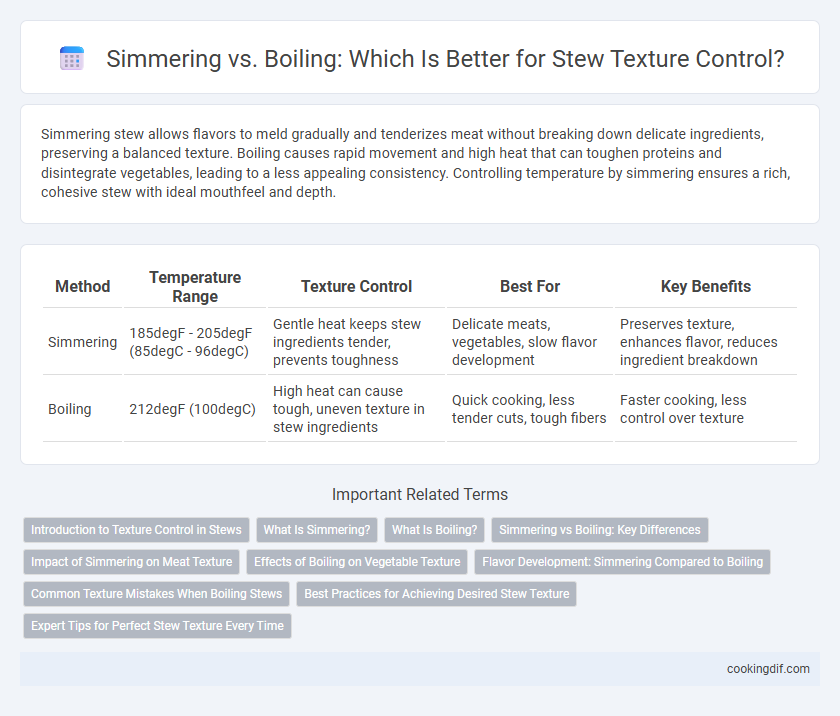Simmering stew allows flavors to meld gradually and tenderizes meat without breaking down delicate ingredients, preserving a balanced texture. Boiling causes rapid movement and high heat that can toughen proteins and disintegrate vegetables, leading to a less appealing consistency. Controlling temperature by simmering ensures a rich, cohesive stew with ideal mouthfeel and depth.
Table of Comparison
| Method | Temperature Range | Texture Control | Best For | Key Benefits |
|---|---|---|---|---|
| Simmering | 185degF - 205degF (85degC - 96degC) | Gentle heat keeps stew ingredients tender, prevents toughness | Delicate meats, vegetables, slow flavor development | Preserves texture, enhances flavor, reduces ingredient breakdown |
| Boiling | 212degF (100degC) | High heat can cause tough, uneven texture in stew ingredients | Quick cooking, less tender cuts, tough fibers | Faster cooking, less control over texture |
Introduction to Texture Control in Stews
Simmering gently breaks down tough meat fibers while retaining moisture, resulting in tender, succulent stew textures. Boiling rapidly agitates ingredients, often causing proteins to toughen and vegetables to disintegrate, which can lead to a mushy consistency. Precise control of heat levels during simmering is essential for achieving the perfect balance of softness and firmness in stew components.
What Is Simmering?
Simmering is a cooking technique where liquid is maintained at a temperature just below boiling, typically between 185degF and 205degF (85degC to 96degC), allowing gentle bubble formation. This precise temperature control helps break down tough meat fibers slowly, resulting in tender texture without toughening proteins. Unlike boiling, simmering prevents food from becoming overcooked or mushy, making it ideal for stew preparation.
What Is Boiling?
Boiling occurs when liquid reaches 212degF (100degC), producing vigorous bubbles that rapidly agitate ingredients, leading to faster cooking but potential toughness in meats and vegetables. This high-heat method breaks down fibers quickly but can cause proteins to contract and become chewy, affecting the stew's overall texture. Controlling temperature by simmering instead can preserve tenderness, as it maintains a gentler heat below boiling point.
Simmering vs Boiling: Key Differences
Simmering maintains a gentle heat just below boiling point, around 185degF to 205degF, allowing stew ingredients to cook evenly and develop tender textures without breaking down. Boiling reaches 212degF, causing vigorous bubbles that can toughen meat and disperse flavors, leading to a less controlled texture. Choosing simmering over boiling in stew preparation ensures a balanced, rich consistency by slowly melding flavors and preserving ingredient integrity.
Impact of Simmering on Meat Texture
Simmering maintains a gentle heat that breaks down collagen in meat slowly, resulting in a tender, succulent texture essential for perfect stew consistency. Boiling meat at high temperatures causes toughening and uneven cooking, compromising the desired melt-in-the-mouth quality. Controlled simmering ensures connective tissues dissolve without overcooking, preserving moisture and enhancing flavor absorption.
Effects of Boiling on Vegetable Texture
Boiling vegetables during stew preparation causes cell walls to break down rapidly, leading to a softer, sometimes mushy texture that can diminish the overall dish quality. Simmering at lower temperatures preserves cellular structure by slowing enzymatic degradation, maintaining a firmer, more desirable vegetable texture. Controlling heat levels between simmering and boiling is crucial for achieving optimal texture in vegetable stews.
Flavor Development: Simmering Compared to Boiling
Simmering enhances flavor development in stews by allowing gradual extraction of flavors from ingredients without breaking down delicate textures or causing excessive evaporation. Boiling, at higher temperatures, can intensify bitterness and cause tougher meat fibers, leading to a less balanced taste. Controlled simmering promotes tender textures and rich, well-integrated flavors essential for a quality stew.
Common Texture Mistakes When Boiling Stews
Boiling stews often leads to tough, overcooked meat and mushy vegetables due to the high temperatures breaking down proteins and fibers too aggressively. Simmering at a lower, steady heat preserves the integrity of meat and vegetables, resulting in a tender texture with well-developed flavors. Common texture mistakes during boiling include dry, stringy meat and disintegrated vegetables, which simmering helps to avoid by maintaining gentle heat and controlled cooking times.
Best Practices for Achieving Desired Stew Texture
Simmering stew at a low, consistent temperature between 185degF and 205degF allows collagen and connective tissues to break down slowly, resulting in tender meat and a rich, velvety texture. Boiling, with temperatures at or above 212degF, can cause meat to seize and toughen, while also breaking down delicate vegetables and creating a cloudy broth. Maintaining a gentle simmer and monitoring heat levels are essential best practices for achieving a smooth, well-balanced stew texture.
Expert Tips for Perfect Stew Texture Every Time
Simmering is essential for achieving tender, evenly cooked stew ingredients, as it allows flavors to meld slowly without breaking down textures. Boiling can make tough cuts of meat and vegetables turn mushy, compromising the stew's desired consistency. Experts recommend maintaining a gentle simmer around 185degF to 205degF for precise texture control and a rich, balanced stew.
Simmering vs boiling for texture control Infographic

 cookingdif.com
cookingdif.com